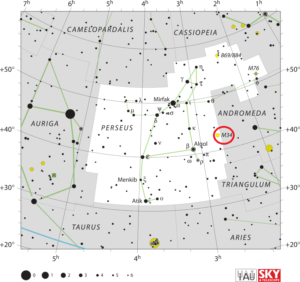Messier 34 (M34) is a bright, large open cluster located in the northern constellation Perseus. Messier 34 is one of the nearest Messier objects to Earth, with only 6 deep sky objects in the Messier catalogue that are closer. Messier 34 is one of only two deep sky objects located in Perseus constellation that were catalogued by Messier. The other one is Messier 76, the Little Dumbbell Nebula, one of the four planetary nebulae included in Messier’s catalogue.
| Description | |
| Visible From Pacific Northwest | September to December |
| Best Time To Observe | October |
| Minimum Size Of Viewing Device | Small Telescopes |
| Object Type | Open Cluster |
| Designations | Messier 34, M34, NGC 1039, Collinder 31, OCl 382, C 0238+425, MWSC 0223 |
| Right Ascension | 02h 42.1m |
| Declination | +42°46′ |
| Constellation | Perseus |
| Age | 200 to 250 million years |
| Apparent magnitude | +5.5 |
| Apparent dimensions | 35′ |
| Object Radius | 7 light years |
| Distance From Earth | 1,500 light years |
History
Messier 34 was discovered by the Italian astronomer Giovanni Batista Hodierna before 1654. Charles Messier found it independently on August 25, 1764 and included it in his catalogue.
In 1983, scientists discovered that the spatial motion of M34 coincided with that of the Pleiades cluster (Messier 45) in Taurus, the open cluster NGC 2516 and the Southern Pleiades (Theta Carinae Cluster, IC 2602) in Carina, the Delta Lyrae Cluster (Stephenson I) in Lyra, and the Alpha Persei Cluster in Perseus. American astronomer Olin J. Eggen, who made the discovery, called this group of open clusters the Local Association. The stars in these clusters share a common age and place of origin.
Locating M34 In The Sky
Messier 34 is pretty easy to find in the sky. The cluster is located just to the north of the imaginary line drawn from Algol, the second brightest star in Perseus, to Almach, the third brightest star in the neighbouring constellation Andromeda. The cluster lies 5 degrees northwest of Algol, a famous eclipsing binary star also known as the Demon Star, that represents the head of the Gorgon Medusa, held by Perseus after his victory over the snake-haired monster.

Viewing M34
Messier 34 and its stars can be resolved even in 10×50 binoculars. The best way to view M34 is in telescopes at low magnifications. Small telescopes will reveal up to 20 stars, while larger amateur telescopes show about 80 members, many of them arranged in pairs. The best time of year to observe the cluster from northern latitudes is in the months of October, November and December.
Photographing M34
Messier 34 lacks a cool nickname, which some have attributed to the reason it lacks interest from the amateur astronomy community. Regardless of the reason, Messier 34 is a bright and large object that doesn’t require much time to image in detail. Using a larger telescope, with accurate guiding for crisp stars, one can utilize a DSLR to take impressive images of M34. Using 3 minute exposures, one can obtain an impressive image in as little as 1 hour.
Sources And Further Reading
Descriptions of all of Messier Objects can be found here.
https://www.messier.seds.org/m/m034.html
https://freestarcharts.com/messier-34
https://www.galactic-hunter.com/post/m34-open-cluster-in-perseus

Be the first to comment on "Messier 34"